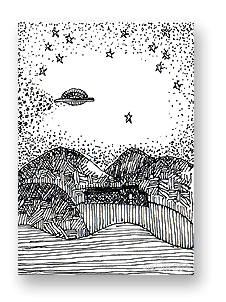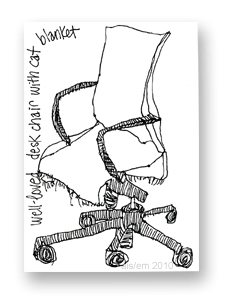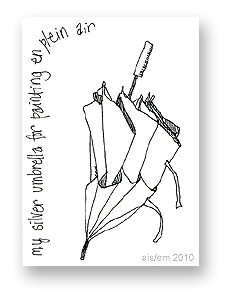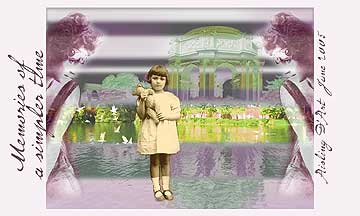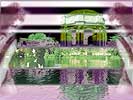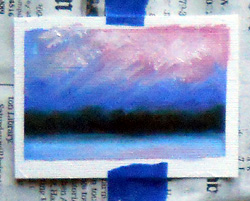 I’m trying some oil paintings as ACEOs. (That stands for Art Card limited Editions and Originals, a kind of artists’ trading cards.)
I’m trying some oil paintings as ACEOs. (That stands for Art Card limited Editions and Originals, a kind of artists’ trading cards.)
Because traditional art cards (including ACEOs) are the same size as other trading cards (like baseball cards, etc.), the 2.5″ x 3.5″ ACEOs can be tricky to work with if you’re painting with oils or acrylics.
My first attempt revealed a few flaws that I’ll fix with the next batch. However, here’s what I did:
First, I covered a masonite sketch board (shown below, at right) with newspaper, held in place by a Very Big Elastic. (The elastic comes with the sketch board when you buy it at any arts or crafts store, or you can simply use one from other packaging… but you may not need it at all.)
Then, I positioned a series of blank ATCs (artist trading cards) approximately where I figured they should be, to mask them. (Michael’s and other stores sell these canvas-textured blanks in the same aisle as their fine art drawing & painting supplies.)
Next, I used blue (easy to peel off) painter’s masking tape to tack blank ACEOs in place.
After that, I laid down strips of that same tape, masking the edges of the cards, usually about 1/4 inch. (That’s not shown in the photo.)
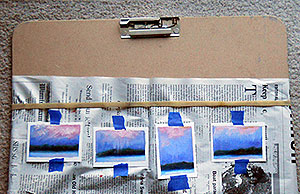 And then, of course, I painted them… at least with an underpainting (my signature cadmium red) and then the first layer of oil paint.
And then, of course, I painted them… at least with an underpainting (my signature cadmium red) and then the first layer of oil paint.
Impatient to see how they’ll look, I peeled off the long strips of masking tape. The result is in the photo on the right.
One card tore slightly as I was peeling off the tape. (The tear was a small surface tear and it can be repaired with glue.) I’m not sure if that issue can be wholly avoided with this process, but I’ll keep experimenting.
I tweaked some of the cards while this first layer of paint is wet. I wanted to cover the cadmium red that had seeped under the tape more than the oil paint did. Alas, some of the tweaking ventured into the ACEOs’ white margins.
While these cards dry, I’m starting a new batch of ACEOs. This time, I used a ruler to position the cards and the tape, so it’s more regular. So far, so good.
The oil paint will take at least a week or two to dry enough for the next layer of paint, so these cards won’t be completed very quickly. I’m aiming to have the first batch of ACEOs ready to ship in about a month.
However, I see several merits to using ACEOs for oil paint (or acrylics):
1. These allow me to experiment with designs on a small scale, to evaluate them for larger paintings. These cards are sort of like thumbnail sketches, but more finished.
2. I can sell these ACEOs for far less than my paintings, making them easy for new art collectors to purchase. (I’m very enthusiastic about the Cheap Art Manifesto as much as it’s practical… while still being a professional artist.)
3. Shipping the ACEOs will involve wax paper (to protect the surface of the card) and some cardboard rectangles as support in the mail. Then, each card can go in an envelope… cheap and easy!
As soon as I’ve worked out more of the bugs, I’ll create a sheet that you can easily use to layout the blank cards yourself, if you’d like to try a painterly approach to ACEOs.

